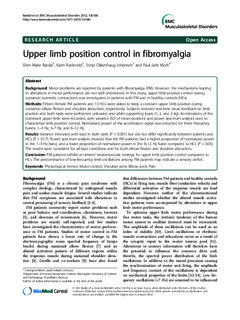| dc.contributor.author | Bardal, Ellen Marie | |
| dc.contributor.author | Roeleveld, Karin | |
| dc.contributor.author | Johansen, Tonje Okkenhaug | |
| dc.contributor.author | Mork, Paul Jarle | |
| dc.date.accessioned | 2015-09-21T13:13:09Z | |
| dc.date.accessioned | 2016-04-21T10:57:39Z | |
| dc.date.available | 2015-09-21T13:13:09Z | |
| dc.date.available | 2016-04-21T10:57:39Z | |
| dc.date.issued | 2012 | |
| dc.identifier.citation | BMC Musculoskeletal Disorders 2012, 13(186) | nb_NO |
| dc.identifier.issn | 1471-2474 | |
| dc.identifier.uri | http://hdl.handle.net/11250/2386742 | |
| dc.description.abstract | Background: Motor problems are reported by patients with fibromyalgia (FM). However, the mechanisms leading
to alterations in motor performance are not well understood. In this study, upper limb position control during
sustained isometric contractions was investigated in patients with FM and in healthy controls (HCs).
Methods: Fifteen female FM patients and 13 HCs were asked to keep a constant upper limb position during
sustained elbow flexion and shoulder abduction, respectively. Subjects received real-time visual feedback on limb
position and both tasks were performed unloaded and while supporting loads (1, 2, and 3 kg). Accelerations of the
dominant upper limb were recorded, with variance (SD of mean position) and power spectrum analysis used to
characterize limb position control. Normalized power of the acceleration signal was extracted for three frequency
bands: 1–3 Hz, 4–7 Hz, and 8–12 Hz.
Results: Variance increased with load in both tasks (P < 0.001) but did not differ significantly between patients and
HCs (P > 0.17). Power spectrum analysis showed that the FM patients had a higher proportion of normalized power
in the 1–3 Hz band, and a lower proportion of normalized power in the 8–12 Hz band compared to HCs (P < 0.05).
The results were consistent for all load conditions and for both elbow flexion and shoulder abduction.
Conclusion: FM patients exhibit an altered neuromuscular strategy for upper limb position control compared to
HCs. The predominance of low-frequency limb oscillations among FM patients may indicate a sensory deficit. | nb_NO |
| dc.language.iso | eng | nb_NO |
| dc.publisher | BioMed Central | nb_NO |
| dc.rights | Navngivelse 3.0 Norge | * |
| dc.rights.uri | http://creativecommons.org/licenses/by/3.0/no/ | * |
| dc.title | Upper limb position control in fibromyalgia | nb_NO |
| dc.type | Journal article | nb_NO |
| dc.type | Peer reviewed | nb_NO |
| dc.date.updated | 2015-09-21T13:13:09Z | |
| dc.source.volume | 13 | nb_NO |
| dc.source.journal | BMC Musculoskeletal Disorders | nb_NO |
| dc.source.issue | 186 | nb_NO |
| dc.identifier.doi | 10.1186/1471-2474-13-186 | |
| dc.identifier.cristin | 984483 | |
| dc.description.localcode | © Bardal et al.; licensee BioMed Central Ltd. 2012. This article is published under license to BioMed Central Ltd. This is an Open Access article distributed under the terms of the Creative Commons Attribution License ( http://creativecommons.org/licenses/by/2.0), which permits unrestricted use, distribution, and reproduction in any medium, provided the original work is properly cited. | nb_NO |

